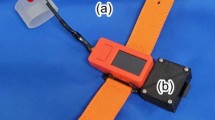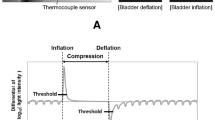Abstract
Capillary refilling time (CRT) is defined as the time taken for the distal capillary bed to regain its color after the capillaries have been blanched through external skin compression. Measuring the CRT is a simple method of evaluating peripheral circulation in the clinic. Typically, the CRT is measured by manually recording the time taken for the skin color to be regained after blanching using a timer. However, this method is observer-dependent, which results in variability and subjectivity. In this study, a portable CRT measurement device was developed for simple quantitative measurement. This device standardizes the operator’s manual compression by measuring the manual compression force using a force sensor and displaying it as well as the duration of the compression on a display unit. The device also measures CRT by recording the change in skin color after fingertip compression using an RGB color sensor. The stability of CRT measurement by this device was compared with that of conventional CRT measurement, which involves manual compression and naked eye observation. These results showed that CRT measurement using this device was more stable than that by the conventional method. The proposed device can potentially improve the reliability of CRT measurement by reducing the variability in the manual compression force and ensuring accurate recording of the time.











Similar content being viewed by others
Explore related subjects
Discover the latest articles, news and stories from top researchers in related subjects.References
Pickard A, Karlen W, Ansermino JM (2011) Capillary refill time: is it still a useful clinical sign? Anesth Analg 113(1):120–123
Lima A, Bakker J (2005) Noninvasive monitoring of peripheral perfusion. Intensive Care Med 31(10):1316–1326
King D, Morton R, Bevan C (2014) How to use capillary refill time. Arch Dis Child Educ Pract Ed 99(3):111–116
Sansone CM, Prendin F, Giordano G, Casati P, Destrebecq A, Terzoni S (2017) Relationship between capillary refill time at triage and abnormal clinical condition: a prospective study. Open Nurs J 11(1):84–90
Lewin J, Maconochie I (2008) Capillary refill time in adults. Emerg Med J 25(6):325–326
Ait-Oufella H et al (2014) Capillary refill time exploration during septic shock. Intensive Care Med 40(7):958–964
Hernandez G et al (2012) Evolution of peripheral vs metabolic perfusion parameters during septic shock resuscitation. A clinical-physiologic study. J Crit Care 27(3):283–288
Lara B et al (2017) Capillary refill time during fluid resuscitation in patients with sepsis-related hyperlactatemia at the emergency department is related to mortality. PLoS ONE 12(11):e0188548
Hariri G et al (2019) Narrative review: clinical assessment of peripheral tissue perfusion in septic shock. Ann Intensive Care 9(1):37
Lima A, van Genderen ME, van Bommel J, Klijn E, Jansem T, Bakker J (2014) Nitroglycerin reverts clinical manifestations of poor peripheral perfusion in patients with circulatory shock. Crit Care 18(3):R126
Jacquet-Lagrèze M et al (2019) Capillary refill time variation induced by passive leg raising predicts capillary refill time response to volume expansion. Crit Care 23(1):281
Kumar N, Thomas N, Singhal D, Puliyel JM, Sreenivas V (2003) Triage score for severity of illness. Indian Pediatr 40(3):204–210
Horne S, Vassallo J, Read J, Ball S (2013) UK triage—an improved tool for an evolving threat. Injury 44(1):23–28
Garner A, Lee A, Harrison K, Schultz CH (2001) Comparative analysis of multiple-casualty incident triage algorithms. Ann Emerg Med 38(5):541–548
Carcillo JA (2012) Capillary refill time is a very useful clinical sign in early recognition and treatment of very sick children. Pediatr Crit Care Med 13(2):210–212
Fleming S, Gill PJ, Van den Bruel A, Thompson M (2016) Capillary refill time in sick children: a clinical guide for general practice. Br J Gen Pract 66(652):587–588
Raimer PL, Han YY, Weber MS, Annich GM, Custer JR (2011) A normal capillary refill time of ≤ 2 seconds is associated with superior vena cava oxygen saturations of ≥ 70%. J Pediatr 158(6):968–972
Canavan A, Arant BSJ (2009) Diagnosis and management of dehydration in children. Am Fam Physician 80(7):692–696
Espinoza EDV, Welsh S, Dubin A (2014) Lack of agreement between different observers and methods in the measurement of capillary refill time in healthy volunteers: an observational study. Rev Bras Ter Intensiv 26(3):269–276
Anderson B, Kelly A, Kerr D, Jolley D (2008) Capillary refill time in adults has poor inter-observer agreement. Hong Kong J Emerg Med 15(2):71–74
Anderson B, Kelly A-M, Kerr D, Clooney M, Jolley D (2008) Impact of patient and environmental factors on capillary refill time in adults. Am J Emerg Med 26(1):62–65
Klupp NL, Keenan A-M (2007) An evaluation of the reliability and validity of capillary refill time test. Foot 17(1):15–20
Blaxter LL et al (2016) An automated quasi-continuous capillary refill timing device. Physiol Meas 37(1):83–99
Oi Y et al (2018) Association between venous blood lactate levels and differences in quantitative capillary refill time. Acute Med Surg 5(4):321–328
Yasufumi O et al (2019) Quantitative capillary refill time predicts sepsis in patients with suspected infection in the emergency department: an observational study. J Intensive Care 7(1):29
Shinozaki K et al (2019) Low temperature increases capillary blood refill time following mechanical fingertip compression of healthy volunteers: prospective cohort study. J Clin Monit Comput 33(2):259–267
Shinozaki K et al (2021) Evaluation of accuracy of capillary refill index with pneumatic fingertip compression. J Clin Monit Comput 35(1):135–145
Yamamoto M et al (2020) Pulse oximetry-based capillary refilling evaluation predicts postoperative outcomes in liver transplantation: a prospective observational cohort study. BMC Anesthesiol 20(1):251
Shinozaki M et al (2019) Feedback function for capillary refilling time measurement device. Crit Care 23(1):295
Shinozaki K et al (2019) Does training level affect the accuracy of visual assessment of capillary refill time? Crit Care 23(1):157
Chang TP et al (2017) Use of a novel, portable, LED-based capillary refill time simulator within a disaster triage context. Prehospital Disaster Med 32(4):451–456
John RT, Henricson J, Nilsson GE, Wilhelms D, Anderson CD (2018) Reflectance spectroscopy: to shed new light on the capillary refill test. J Biophotonics 11(1):e201700043
de Souza RP, Cardoso GC (2021) Skin color independent robust assessment of capillary refill time. ArXiv210213611 Phys. Accessed 30 Aug 2021
Shinozaki K et al (2021) The standardized method and clinical experience may improve the reliability of visually assessed capillary refill time. Am J Emerg Med 44:284–290
W. Karlen et al (2011) Automated validation of capillary refill time measurements using photo-plethysmogram from a portable device for effective triage in children. In: 2011 IEEE global humanitarian technology conference, Seattle, WA, USA, pp. 66–71
Sheridan DC, Cloutier RL, Samatham R, Hansen ML (2021) Point-of-care capillary refill technology improves accuracy of peripheral perfusion assessment. Front Med 8:694241
Liu C, Correia R, Ballaji H, Korposh S, Hayes-Gill B, Morgan S (2020) Optical fibre sensor for simultaneous measurement of capillary refill time and contact pressure. Sensor 20(5):1388
Kawaguchi R et al (2019) Optimal pressing strength and time for capillary refilling time. Crit Care 23(1):4
Xuemin S, Yi G, Shogo F, Hisashi U, Ichiro F (2001) A new diagnostic system for Alzheimer’s disease using miotic reflex to flashlight. Jpn J Med Electron Biol Eng 39(2):102–108
Nagai D, Hasegawa K (1986) A study on auditory and visual response time. Jpn J Showa Med Assoc 46(1):27–34
Yoshida S, Park I (1999) Reaction time delay due to eyeblinks in push-button tasks. Bull Inst Health Sport Sci Univ Tsukuba 22:109–117
Acknowledgements
We thank Mr. Takaya Ishikawa and Mr. Kyohei Fukuda for adjusting the device.
Author information
Authors and Affiliations
Corresponding author
Additional information
Publisher's Note
Springer Nature remains neutral with regard to jurisdictional claims in published maps and institutional affiliations.
About this article
Cite this article
Shinozaki, M., Shimizu, R., Saito, D. et al. Portable measurement device to quantitatively measure capillary refilling time. Artif Life Robotics 27, 48–57 (2022). https://doi.org/10.1007/s10015-021-00723-w
Received:
Accepted:
Published:
Issue Date:
DOI: https://doi.org/10.1007/s10015-021-00723-w




